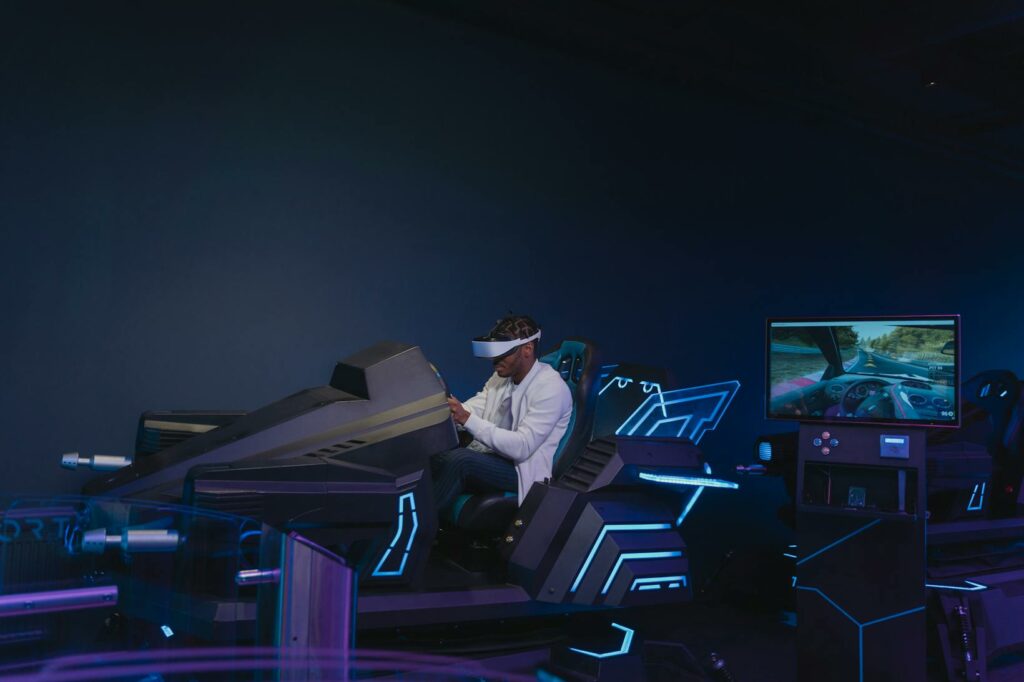Immerse yourself in the world of virtual reality (VR), where the only limit is your imagination. The VR controller is your magic wand, opening doors to new dimensions and experiences. It’s not just about gaming anymore, it’s about living in the game, feeling every swing, every punch, every move.
But what makes a good VR controller? How do they work, and how can you get the best out of them? Whether you’re a seasoned gamer or a curious novice, this article will guide you through the fascinating landscape of VR controllers, their evolution, and their impact on the VR experience. Dive in, and let’s explore this exciting world together.
VR Controllers
 Delving beyond an introductory understanding, it’s pivotal to gain a comprehensive insight into the world of VR controllers.
Delving beyond an introductory understanding, it’s pivotal to gain a comprehensive insight into the world of VR controllers.
The journey of VR controllers traces from simplistic designs to more sophisticated, immersion-enhancing tools. Early models, akin to regular gaming joysticks, offered limited interaction but marked the dawn of a new era in virtual reality.
Fast forward to the current scenario, advancements in technology brought forth controllers that mimic real-world physics, offering more intuitive interactions in the virtual environment. For instance, creating virtual items in a VR game feels no longer abstract, rather it feels tangibly real, thanks to the evolution of these critical devices.
Different Types of VR Controllers
A myriad of VR controllers are available in the marketplace, each varying in design and functionality. Classic wand-style controllers, popularized by platforms such as HTC Vive and Oculus Rift, offer a balanced blend of ergonomics and functionality.
Conversely, glove-based controllers provide additional degrees of freedom and resemble natural hand actions, perfect examples being Manus VR and HaptX Gloves. Additionally, there exist hybrid controllers that rope in best of both worlds, like Valve’s Index controllers.
It’s indeed crucial to understand the strengths and limitations of these varied VR controllers, to achieve an ideal virtual reality experience.
Key Features of VR Controllers
 To fully captivate users in the VR realm, controllers embody certain fundamental elements. Motion tracking and feedback mechanisms contribute directly to their effectiveness.
To fully captivate users in the VR realm, controllers embody certain fundamental elements. Motion tracking and feedback mechanisms contribute directly to their effectiveness.
Additionally, controllers like Valve’s Index offer finger-tracking for more natural interactions, further enhancing immersion. This evolution in VR controllers continues to push boundaries in virtual experiences.
Motion Tracking in VR Controllers
An integral aspect of VR controllers is motion tracking. This function translates real-world physical movements into corresponding actions within the VR environment. Motion tracking involves complex technology using infrared sensors, gryometers, and accelerometers.
For instance, the Oculus Rift’s Touch Controller implements precise motion tracking. It offers users a natural and immersive experience by replicating their hand actions perfectly in the virtual world.
Feedback Mechanisms in VR Controllers
Advancements in VR technology have incorporated effective feedback mechanisms into VR controllers. These mechanisms provide sensory responses to the user’s actions, enhancing their immersive experience.
Vibration or haptic feedback is the most common example of this feature. It informs users about interactions or events within the game by generating vibrations in the controller. The PlayStation VR Aim Controller, in an effort to heightargeted immersion, integrates this feature expertly, generating vibrations that correlate to in-game shooting, thus intensifying the sensation of firing virtual weapons.
From Joysticks to Glove
 VR controllers are the gateway to a fully immersive virtual reality experience. They’ve evolved from basic wand-style controllers to sophisticated glove-based and hybrid types, each with their own unique offerings. The magic lies in the motion tracking technology, converting real-world movements into VR actions with precision. It’s the Oculus Rift’s Touch Controller that stands out for its accuracy in this aspect. Feedback mechanisms, too, play a pivotal role in enhancing the VR experience.
VR controllers are the gateway to a fully immersive virtual reality experience. They’ve evolved from basic wand-style controllers to sophisticated glove-based and hybrid types, each with their own unique offerings. The magic lies in the motion tracking technology, converting real-world movements into VR actions with precision. It’s the Oculus Rift’s Touch Controller that stands out for its accuracy in this aspect. Feedback mechanisms, too, play a pivotal role in enhancing the VR experience.
They provide sensory responses, like the PlayStation VR Aim Controller’s vibration feedback, which heightens the sensation of in-game shooting. It’s clear then, that an understanding of VR controllers’ strengths and limitations is key to unlocking the best VR experience possible. VR controllers aren’t just an accessory, they’re an essential part of the VR journey.

